Exploring the Geological and Historical Aspects of Moldavite
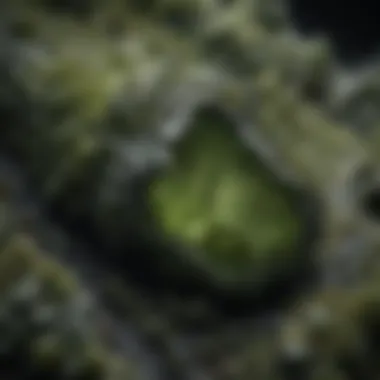
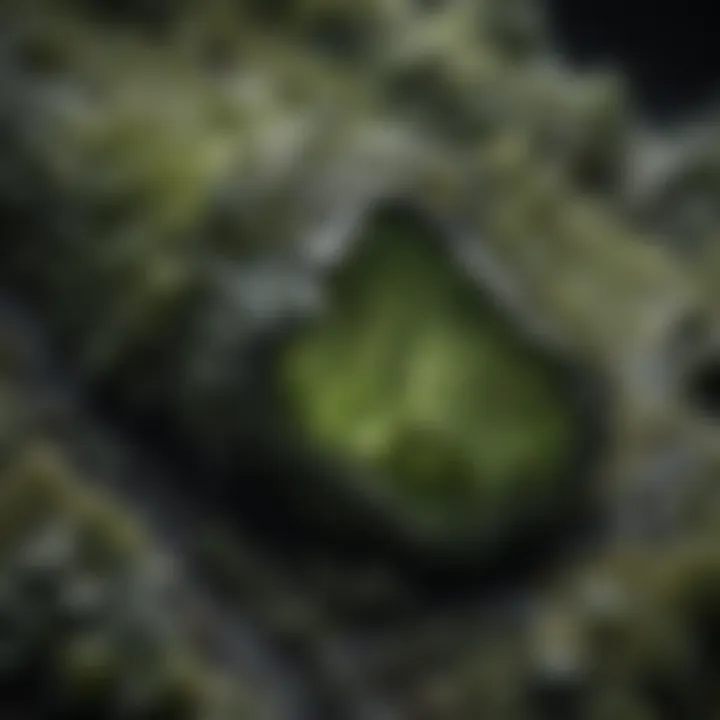
Intro
The allure of moldavite, a stunning green stone with an intriguing backstory, captivates many who come across it. Formed millions of years ago through intense meteorite impacts, this unique tektite embodies the intersection of geological wonders and human curiosity. Those who delve into its origins might find themselves pondering not just its creation, but the rich service it has rendered to both science and culture.
Exploring the path moldavite traversed from the cosmos to Earth unveils a complex narrative, intertwining natural disasters, geological phenomena, and human history. It's more than a mere gemstone; it stands as a witness to the turbulent ancient past of our planet. Its significance reverberates through time, resonating with scientists, gem enthusiasts, and spiritual seekers alike.
In this article, we will journey through the geological processes that birthed moldavite, peeling back the layers of time to reveal its historical context and enduring importance. As we navigate these interconnected narratives, we aim to offer a clear and engaging perspective on what makes moldavite so captivating, not just as a relic of the past, but as a symbol of our ongoing relationship with nature.
Article Overview
Purpose of the Article
The aim here is straightforward: to shine a light on the geological mysteries surrounding moldavite while also emphasizing its historical significance. By unpacking the scientific underpinnings of its formation and tracing its cultural implications, we hope to provide readers with a multifaceted understanding that transcends superficial allure.
Relevance to Multiple Disciplines
Moldavite serves as a prime example of how natural phenomena can resonate across various fields:
- Geology: Understanding the conditions of its formation involves studying impact events, heat, and pressure.
- History: The story of moldavite is closely linked to human discovery and cultural significance throughout civilizations.
- Metaphysics: Many people believe in the metaphysical properties of moldavite, stirring discussions in spiritual communities.
Each of these areas presents rich narratives, inviting discussion and greater exploration.
Research Background
Historical Context
The journey of moldavite traces back roughly 15 million years to a violent meteorite impact near Bohmen, present-day Czech Republic. After the impact, molten materials fused together, cooling rapidly, and ultimately giving birth to the glimmering pieces we see today. These valuable tidbits serve as tangible remnants from an age when our planet was still in its infancy, constantly undergoing transformation.
Throughout history, moldavite has captured human imagination—used by various cultures, from the Celts to modern metaphysical societies. Carvings and artifacts found near its origin suggest that even early peoples recognized its unique properties and significance.
Key Concepts and Definitions
Before diving deeper, it is essential to set a few foundational terms:
- Tektite: Naturally occurring glass formed from terrestrial debris ejected during meteorite impacts.
- Impact event: A scenario where a meteorite strikes Earth's surface, leading to extensive geological changes.
- Culture significance: The ways in which substances like moldavite are perceived, valued, and used across different societies.
Understanding these concepts will provide a clearer framework as we delve into the fascinating journey of moldavite and its continuing relevance in today’s world.
“Moldavite is not just a gem; it is a cosmic connection to what once was.”
“Moldavite is not just a gem; it is a cosmic connection to what once was.”
The story of moldavite is one of both earth and sky, offering insights into our natural world and the interplay of geological forces. As we move further into its narrative, the pertinence of this remarkable stone will unveil itself as a testament to both nature’s grandeur and humanity’s eternal curiosity.
Prelude to Moldavite
Moldavite is more than just a geological curiosity; it represents a crossroads of science, culture, and metaphysics. Understanding moldavite's origins gives important insights applicable to various fields, from geology to anthropology. The story of moldavite begins with a cosmic event that shaped not only the material itself but also cultures across time. As we embark on this exploration, we find the intersection of earthly and extraterrestrial phenomena, illuminating why moldavite captivates scientists and spiritual seekers alike.
Definition and Characteristics
Moldavite is a form of tektite, a glassy substance created from the intense heat and pressure in the aftermath of a meteorite impact. Specifically, it hails from the region of the Moldau River in the Czech Republic. Unlike other tektites, moldavite is characterized by its distinctive green color, which can vary from light to dark. This striking coloration is akin to the hues one might find in a lush forest, adding to its allure.
The texture of moldavite presents an array of fascinating forms, often exhibiting pitting and striations that reflect its fiery birth. With a density slightly lighter than quartz, the almost ethereal nature of moldavite sets it apart from other stones, beckoning those with a keen eye for the extraordinary.
Cultural Importance
Historical uses
Historically, moldavite has held immense significance in various cultures. Ancient civilizations from the Celts to early European tribes regarded moldavite as a mystical stone, believed to possess protective and transformative properties. It's famously said that moldavite was used to craft amulets and talismans, embodying the belief that it could ward off misfortune. This historical context of use showcases how different peoples projected their understanding of the cosmos onto this substance, defining their relationship with the universe in a physical form.
The material's ability to connect humanity with celestial events established it as a vital component in ritualistic practices. By incorporating moldavite into daily life, early civilizations passed down tales, enhancing its reputation over generations. The legacy of moldavite as a symbolic artifact continues to contribute to its appeal, making it an attractive topic for those studying ancient cultures.
Symbolism in different cultures
Symbolically, moldavite transcends boundaries, resonating deeply within various cultures. Often viewed as a stone of transformation, many people believe that moldavite encourages spiritual evolution and personal growth. It has been associated with the heart chakra in alternative healing practices, implying a connection that aids methods of healing and emotional balance.
In many traditions, moldavite is seen as a bridge to higher realms of consciousness, facilitating a deeper understanding of one’s place in the universe. This unique feature of moldavite allows it to occupy a niche that appeals to those interested in both spirituality and geology, gaining traction in communities drawn to holistic healing.
Moldavite's narrative encapsulates a fascinating blend of geological wonder and rich human history. As we peel back the layers of its significance, we transition into understanding the geological processes that birthed this remarkable material.
Geological History of Moldavite
Understanding the geological history of Moldavite is akin to peeling back the layers of a complex onion. Each layer reveals not just the physical transformation that this unique gemstone underwent, but also the cosmic events that shaped it. The origin of Moldavite lies in a dramatic impact event, which not only transformed the Earth’s surface but also birthed a distinct type of tektite. This section embarks on an exploration of the formative events that led to the creation of Moldavite, shedding light on the processes that turned earthly materials into the extraordinary.
Formation of Tektites
Impact events
Impact events serve as the primary catalyst for the formation of tektites, including Moldavite. A significant collision with a meteorite around 15 million years ago is believed to have propelled terrestrial materials into the atmosphere. In this chaotic ballet of cosmic forces, the heat generated upon impact melted silicate minerals, which cooled and solidified into different forms, known as tektites.
One of the hallmark characteristics of these impact events is their ability to generate immense temperatures, often exceeding thousands of degrees Celsius. This extreme heat is crucial for melting the surrounding rock, facilitating the formation of tektites. The sheer scale of such events is both daunting and fascinating; they can alter landscapes and radically change geological compositions.
Moreover, the uniqueness of each impact event means that the resulting tektites can vary greatly, leading to a rich world of characteristics within these glassy formations. However, their benefits do come with certain disadvantages, including the difficulties scientists face when mapping the exact impacts and their locations—a task intertwined with ongoing geological studies.
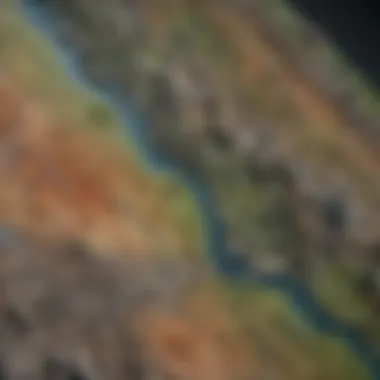
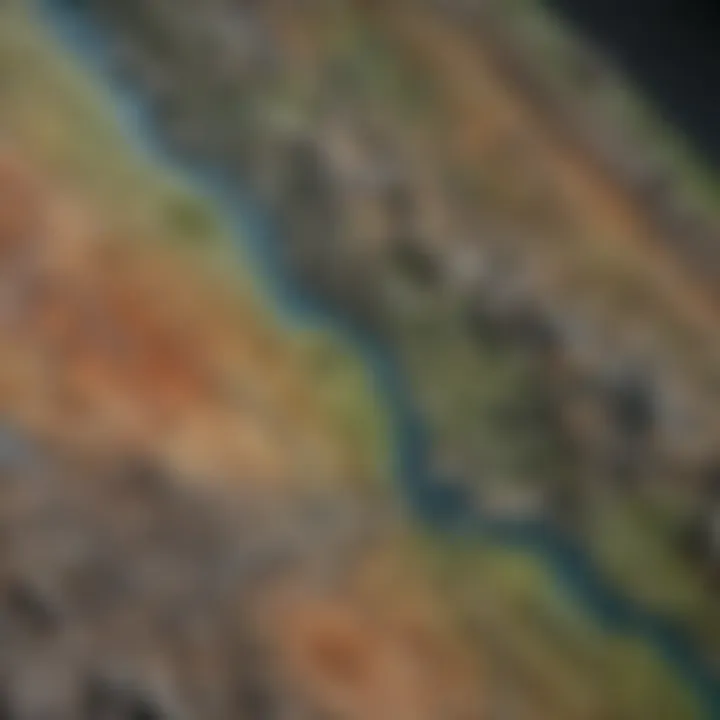
Conditions for tektite formation
The conditions required for tektite formation are specific and critically vital. Besides the initial impact itself, various geological factors must be aligned. For instance, a fine balance between the type of rock struck, the angle of impact, and the energy released during the collision can vastly influence the characteristics of the resulting tektites.
One prime characteristic of these conditions is the requirement for the surrounding material to be both abundant and varied. Over time, sedimentation processes create a rich composite of minerals that may culminate in the formation of tektites. This makes regions such as central Europe, where Moldavite is predominantly found, a treasure trove for geological enthusiasts.
Nonetheless, these ideal conditions aren’t easy to replicate, which adds another layer of complexity to the study of Moldavite. The unique features arising from such specific conditions contribute to the rarity and value of these tektites, positioning them not just as geological curiosities, but also as significant indicators of Earth’s history and cosmic interactions.
Impact Event on Moldavite
Impact site location
The location of the impact that created Moldavite plays a pivotal role in understanding its characteristics and formation. Situated in what is now the region of the Bohemian Forest in the Czech Republic, the site harbors geological anomalies that have piqued scientific interest for decades.
Noteworthy about this location is its prominence in tektite studies. Researchers have trawled through layers of sediment, uncovering clues about the ancient environment at the time of the impact. Additionally, the proximity to uniquely composed deposits can offer insights into how Moldavite formed.
However, the specific details regarding the exact site can lead to discrepancies among researchers. Views on whether the final resting place of the materials is representative of their original state vary, complicating the overall narrative. Nevertheless, this site remains crucial for understanding not just Moldavite, but also the broader implications of meteorite impacts.
Date and scale of the event
The dating of the impact event that gave rise to Moldavite provides a crucial timeline to the study of both the gemstone and the geological processes at play. Geologically, it’s estimated that the impact occurred approximately 15 million years ago, one of the key benchmarks in the context of Earth’s history.
In terms of scale, this event was monumental. It’s speculated that the collision’s sheer force was equivalent to millions of atomic bombs, shattering the landscape and ejecting molten material high into the atmosphere. The aftermath of such a colossal impact landscape was transformational, shaping not just Moldavite but the surrounding geology as well.
The timing and scale of this event also lends credence to further studies into not just Moldavite’s origins but into the cumulative effects of such impacts on the Earth's geology and climate over millions of years. However, some debate remains about the precise timeline, encouraging ongoing research into dating techniques that continue to shed light on this dramatic chapter in Earth's history.
The impact that created Moldavite was colossal, reshaping the Earth’s surface and memory through the ages.
The impact that created Moldavite was colossal, reshaping the Earth’s surface and memory through the ages.
Through this exploration of impact events and their resulting conditions, we grasp a clearer picture of how Moldavite comes to be, setting a cornerstone for both geological appreciation and historical significance.
The Geological Phenomenon of the Moldavite Impact
The fascination surrounding moldavite extends far beyond its beauty; it is the geological phenomena associated with its origins that truly captivates scholars and enthusiasts alike. Moldavite is a vivid illustration of how cosmic events can radically transform terrestrial environments. Understanding the impact of the meteorite that created moldavite unveils not only the circumstances of this unique tektite's birth, but also offers insights into Earth's geological history and processes. This section dives into the surface alterations, modifications in geological layers, and the striking structures that emerged from the impact, showcasing their significance.
Surface Alterations and Effects
Lithological impacts
Lithological impacts refer to the changes in rock types and characteristics resulting from the tremendous forces unleashed during the impact event. When the meteorite collided with the Earth, it didn't just leave a dent; it metamorphosed the surrounding materials. This phenomenon creates an interesting case to study, as each lithological change tells a story about the conditions at play back then.
One notable aspect of these impacts is the thermal alteration of rocks, where extreme temperatures can cause original materials to melt and reform. This process demonstrates the formation of moldavite from metamorphosed silica-rich materials into a glassy texture, which is one of its defining characteristics. The study of lithological impacts is essential for understanding these transformations and their broader implications on Earth's geological evolution.
The main gain from exploring lithological impacts is the potential to identify similar impact structures on other celestial bodies, providing clues about impact geology across the universe. However, there is a trade-off: the complexity of the new formations can obscure the original geological features, making it challenging for researchers to draw clear conclusons.
Formation of unique geological structures
The impact that generated moldavite also led to the creation of remarkable geological structures, which contribute greatly to the scientific significance of the site. These unique formations often consist of unusual rock types and arrangements that would not typically occur in a non-impact setting. For example, the craters formed can exhibit layers of materials deposited in a manner distinct from sedimentary processes.
These formations provide an exceptional opportunity for studying the geological history of the area, as they serve as natural laboratories for observing the aftermath of impact events. One of the most captivating features is how these structures often encapsulate a time capsule of geological and environmental changes.
While these unique forms are advantageous for scientific study, they can also complicate the narrative by introducing variables that may mislead researchers if not carefully analyzed.
Analysis of Geological Layers
Stratigraphy surrounding the impact
Stratigraphy is the study of rock layers and layering, which becomes particularly interesting in contexts where geological events, like the moldavite impact, have shifted the typical order of strata. This layer of complexity offers a window into the geological timeline, allowing us to unravel the events that led to moldavite's existence.
In cases relevant to moldavite, the stratigraphy reveals not just the immediate sequence of rock types resulting from the impact, but also prior geological conditions. This information is critical, as it helps researchers understand the broader geological context in which the moldavite impact occurred, shinning light on different eras of Earth’s history.
A key feature in studying this stratigraphy is its potential to align with radiometric dating methods, creating a timeline that corresponds to major geological epochs. However, reliance on such techniques must be balanced with caution, as the chaotic nature of impact processes can yield misrepresentative information.
Dating techniques used
The ability to accurately date the moldavite impact event plays a crucial role in understanding its historical significance. Various techniques are employed, including radiometric dating, which provides insights into the ages of the minerals involved in the event. These methods can illuminate when exactly the moldavite was formed and how it relates to other planetary developments.
One of the primary techniques utilized is potassium-argon dating, which measures the decay of radioactive potassium isotopes in minerals. This technique has become popular due to its effectiveness over vast timescales. It offers robust data that can pinpoint the formation period of the surrounding geological features.
While dating methods are invaluable for constructing a timeline of geological processes, they also harbor some limitations. The potential for contamination, particularly in layered deposits, can lead to inaccurate readings, which researchers must vigilantly guard against to ensure reliability.
In summary, the geological phenomena resulting from the moldavite impact lay a significant foundation for comprehending both the immediate effects of meteorite collisions and broader geological processes at large. Through a meticulous analysis of surface alterations, geological structures, and layered stratigraphy, scholars can unravel the narrative woven into the fabric of this fascinating tektite.
Morphological and Chemical Composition
Moldavite, a striking green tektite, captures attention not only for its historical and geological significance but also for its unique morphological and chemical composition. This section dives into the intricate details of what makes moldavite stand out in the realm of geological formations.
Mineralogical Aspects
The mineralogical composition of moldavite reveals much about its formation and the conditions under which it formed. Primarily, moldavite is classified as a silica-rich glass, characterized by its glassy texture and amorphous structure. The presence of silica, which forms the backbone of many geological materials, is coupled with a plethora of other oxides. These include alumina, iron oxide, and possibly traces of titanium and manganese. Each of these components contributes to moldavite's distinct color and luster.
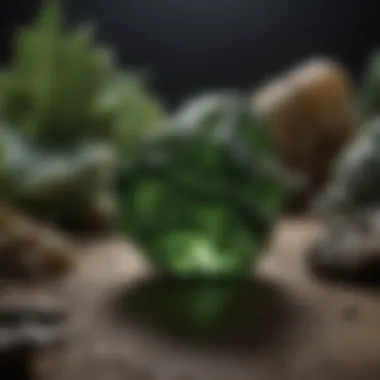
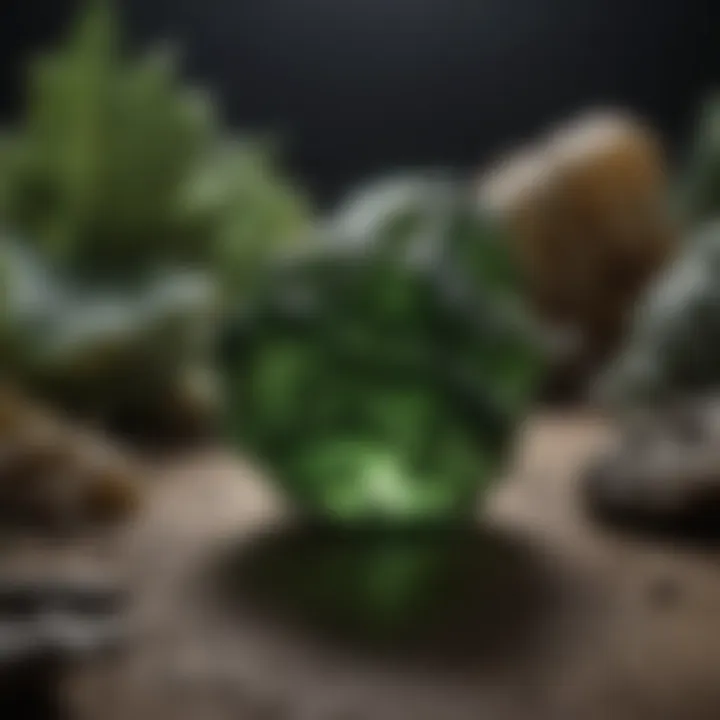
Moldavite's unique mineralogy can be attributed to its rapid cooling from the molten state during the impact events. This makes it different from typical rocks that cool slowly, allowing crystals to form. The rapid cooling suppresses crystalline growth, creating the glassy texture that makes moldavite identifiable.
Chemical Makeup of Moldavite
Moldavite's chemical composition holds key secrets to its origins and properties. Its primary component is silicate, which dictates many of its physical and chemical interactions in both natural and artificial environments.
Silicate composition
The silicate composition of moldavite plays a pivotal role in defining its characteristics. Essentially, moldavite contains a high percentage of silicate, which is crucial in determining the glass's structural properties. This high level of silicon dioxide is significant because it contributes to the tektite's resistance to weathering, making moldavite retain its appearance over long periods.
Moreover, the unique feature of this composition is that it enhances moldavite’s thermal and electrical conductivity, making it a popular choice for specific technological applications. However, its glassy nature can also render it vulnerable to scratches, necessitating careful handling in both personal and scientific contexts.
Trace elements and their significance
The trace elements found within moldavite provide essential insight into its formation and potential applications. Elements such as magnesium, calcium, and iron are present in small quantities, influencing both the color and physical properties of the stone. For example, iron's contribution can change moldavite’s color to a darker green hue.
The presence of these trace elements not only enhances the aesthetic appeal of moldavite but also raises interesting considerations for those studying its geological and metaphysical properties. They can serve as indicators of the specific conditions and environments that existed during the impact event. However, their concentration levels can vary, which poses challenges for consistent classification and use in various applications.
Historical Context of Moldavite Discoveries
Understanding the historical context of moldavite discoveries is crucial in appreciating its significance beyond mere geology. The journey of moldavite from the earth to human hands tells us not just about its formation but also about the cultural narratives that shaped its value and the fervor surrounding it. These elements, intertwined with our history, help contextualize its mystical qualities ascribed through ages.
Early Discoveries
First recorded finds
The first recorded instance of moldavite came to light in the 19th century when the curious stone was discovered near the Vltava River in the Czech Republic. The locals initially regarded moldavite as a mere curiosity, perhaps something to be cast aside or traded without much thought. However, as its unique greenish hue and glassy texture came to the forefront, the moldavite began to attract attention among collectors.
One key characteristic of these early finds is their extraterrestrial origin. The very fact that moldavite was formed from a meteorite impact gives it a mystique that few other minerals possess. This celestial aspect contributes significantly to its allure, making it a noteworthy subject of study in this article. The unique feature of the first recorded finds lies in how they challenged conventional notions of gemstones at the time.
However, early fascination also had its drawbacks. The primitive understanding of geology during that period meant that many approached moldavite with superstition rather than scientific inquiry. Such a limited perspective might have hindered further exploration and appreciation of its true geological significance.
Archaeological significance
Moldavite's archaeological significance cannot be overstated. It has been unearthed in various excavation sites linked to ancient civilizations, such as the Celts. The presence of moldavite in these sites speaks volumes about human interaction with this striking stone long before modern scientific methods defined its properties.
One of its key characteristics is its association with ancient rituals and artifacts, suggesting it was not merely decorative but held a deeper significance perhaps in spiritual beliefs. This aspect positions moldavite as an essential piece in understanding the cultural context of the regions where it has been found. The unique feature here is the realization that moldavite was not just another mineral; it played a role in humanity's quest for meaning and connection to the cosmos.
The implications of archaeological significance carry weight in scholarly analyses today. The intertwined histories of moldavite and humanity add richness to studies on not just geology but sociology and anthropology as well, offering insights into our collective past.
Modern Rediscovery and Trade
Revival in popularity
In the last few decades, moldavite has experienced a renaissance of interest, propelled by both the metaphysical community and collectors of rare gemstones. This revival is not merely an accident; it coincides with a broader societal move toward exploring alternative therapies and cosmic consciousness.
The unique feature of this modern revival is its fusion with New Age practices, as many believe that moldavite carries energetic properties that can promote healing. This contemporary popularity positions moldavite as a prime subject in alternative wellness, educating readers about its modern-day implications.
Despite its growing fame, there are considerations to be made. Some skeptics question the validity of claims surrounding its metaphysical properties, suggesting that these beliefs detract from its geological importance. Balancing these aspects is crucial for a comprehensive understanding of moldavite's role today.
Market dynamics
The current market dynamics surrounding moldavite are both fascinating and complex. As its popularity surged, so too did the market for authentic pieces. Today, collectors and spiritual practitioners vie for genuine moldavite, influencing prices dramatically. This demand, however, can lead to ethical dilemmas concerning mining and sourcing.
A prominent characteristic of these market dynamics is the escalating value of high-quality pieces. Unlike gemstones with abundant supply, moldavite's finite nature leads to inflated prices. This characteristic makes it a significant topic for this article, considering the intricacies of supply and demand in the realm of natural treasures.
The unique feature of the market dynamics is the emergence of counterfeit products, which muddy the waters for honest collectors. Therefore, understanding how to discern authentic moldavite becomes essential for both the consumer and the seller. This complexity highlights the need for informed study into the economic aspect of moldavite, offering insights into consumer behavior, market ethics, and preservation of natural resources in today’s world.
In examining the historical context of moldavite, one can appreciate its dual nature: a scientific wonder and a cultural artifact that continues to evolve within human narratives.
In examining the historical context of moldavite, one can appreciate its dual nature: a scientific wonder and a cultural artifact that continues to evolve within human narratives.
Scientific Studies and Research
Understanding moldavite isn’t just a quirky journey through geology and history; it’s a scientific adventure that opens doors to myriad discoveries. The scientific investigation surrounding moldavite provides crucial evidence about past impact events and offers insights into broader geological phenomena. This section encapsulates the significance of ongoing research in the field relevant to moldavite, emphasizing that the study of this unique tektite goes beyond mere fascination. Through robust research frameworks, scientists are piecing together the geological puzzle, enhancing our comprehension of planetary evolution and the cosmic stories that are locked within these glassy remnants.
Recent Geological Surveys
Current findings
Recent findings from geological surveys have brought the spotlight back on moldavite. With technology advancing, scientists have been able to analyze the properties and formation processes of this striking stone with unprecedented precision. One of the key characteristics that stands out is the identification of moldavite’s unique chemical profile, which is distinct from other tektites found across the globe. This characteristic serves a dual purpose: it not only illuminates the conditions under which moldavite formed but also aids in distinguishing it from counterfeit stones often sold in the market.
Moreover, these findings demonstrate that moldavite’s impact site can be linked directly to the meteorite that caused its creation, leading to a better understanding of the nature of the impact event itself, its scale, and implications. This makes the current findings all the more compelling, as the current body of research enhances our grasp of how terrestrial rocks interacted with extraterrestrial materials during formation.
Methodologies employed
As we peel back the layers of research, it becomes evident that the methodologies employed to study moldavite have become increasingly refined. Techniques like mass spectrometry allow for detailed isotopic analysis, while scanning electron microscopy helps in revealing the microstructural features of the moldavite. This rigorous approach not only strengthens the reliability of findings but also provides a replicable framework for future research endeavors.
Moreover, field studies combined with lab analysis create a comprehensive understanding of moldavite's context within geological formations. While these methodologies offer numerous advantages, their complexity can also pose challenges, particularly when interpreting results in light of varying environmental factors that influenced moldavite’s formation.
The Role of Moldavite in Geosciences
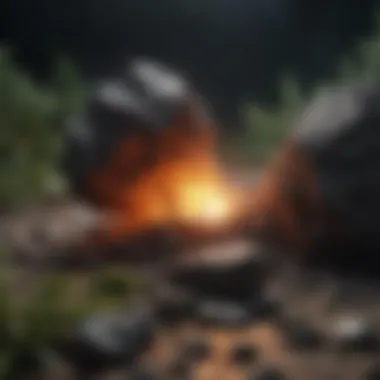
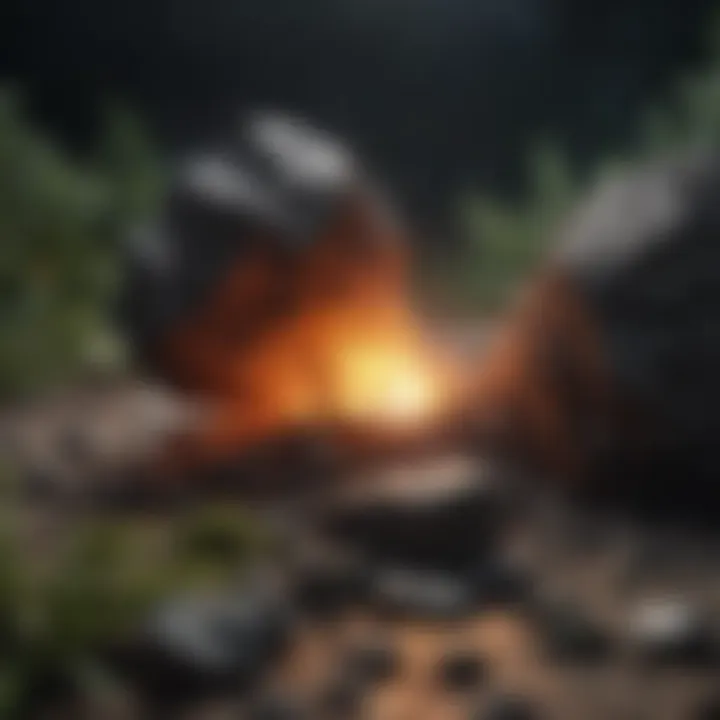
Applications in understanding impact geology
Moldavite serves as an intriguing case study in the wider discipline of impact geology. Its unique formation process sheds light on the effects of extraterrestrial impacts on Earth’s surface. One primary application is the study of shock metamorphism, which occurs when a high-velocity impact generates extreme pressure and temperature conditions. Examining moldavite helps scientists reconstruct these violent events and understand their ramifications for Earth’s geological history.
This leads to exciting revelations about how impact events can catalyze significant changes in Earth's environment, biological systems, and even climate over geological timeframes. Understanding such dynamics opens avenues for further exploration into the Earth's impact history and its implications for future events.
Insights into planetary formation
The insights gleaned from moldavite extend into the realm of planetary formation and evolution. The study of such materials provides critical clues about conditions prevalent during the early solar system, particularly during periods when celestial bodies were bombarding one another. This perspective is essential, as it allows researchers to connect the dots between Earth’s formation and the dynamics of other planetary bodies.
Moreover, analyzing moldavite can yield information about the chemical constituents present in early Earth’s environment, as well as how impacts may have delivered water and organic compounds, instrumental for the emergence of life. However, while the findings are immensely enlightening, the limitations of extrapolating these insights to the broader context of planetary science remain a focus of discussion among scientists, bringing light to the complexities involved in such research.
Cultural and Metaphysical Perspectives
The significance of moldavite stretches far beyond geological narratives. Within this section, we delve into how its existence shapes cultural practices and metaphysical beliefs. Understanding these aspects provides a richer context, placing moldavite not only in the realm of science but also in the hearts and minds of various communities.
Modern Spiritual Practices
Uses in holistic healing
Moldavite has found itself at the forefront of holistic healing techniques. The key characteristic that makes it sought after in this practice is its reputed ability to promote transformation and spiritual growth. Many practitioners in the field believe that moldavite enhances meditation, facilitates emotional release, and supports deep energetic healing.
This gemstone is often considered a catalyst for personal evolution. Users report that holding or wearing moldavite during meditation can lead to profound experiences, often likening it to a bridge between the physical and spiritual realms. Its energetic properties are celebrated for helping individuals break free from limiting beliefs.
However, it is not without its challenges. While many enthusiasts hail its healing powers, some skeptics argue that results can be highly subjective. Proper understanding and respectful usage of moldavite are essential for those engaging in this practice. The potential disadvantage lies in its unpredictability; for some users, it may provoke intense emotional experiences, which can be overwhelming. In summary, its role in holistic healing is that of both a powerful tool and a subject of caution.
Symbolic interpretations
Moldavite also carries a wealth of symbolic interpretations across different cultures. One prominent aspect is its association with the idea of cosmic origin, as it was formed from a meteorite impact. This cosmic link speaks to the interconnectedness of humanity with the universe, making moldavite a symbol of higher consciousness.
Its vibrant green hue is often tied to notions of growth, renewal, and abundance in various spiritual frameworks. Many view moldavite as a reminder of their potential and the boundless possibilities in their lives. In this regard, it becomes a talisman of hope and inspiration.
Nevertheless, like holistic healing practices, the symbolic interpretations of moldavite must be navigated with care. The diversity in meanings might sometimes cause misconceptions or confusion among those seeking its significance. This nuance serves as a reminder that while moldavite is celebrated for its rich symbolism, interpretations can vary widely, depending on personal beliefs or cultural backgrounds. Overall, its symbolic nature enriches the conversation around moldavite’s role in modern spiritual practices.
Moldavite in Popular Culture
As we look at moldavite’s prominence beyond spiritual circles, we also consider its influence in art and literature.
Influence on art and literature
Moldavite has carved out a niche in both modern art and literature. Artists are drawn to its stunning, transparent green color and the narratives behind its origins. Many contemporary sculptures and jewelry pieces incorporate moldavite to symbolize a connection to the Earth and the cosmos.
In literature, references to moldavite often emerge in discussions about spirituality and transformation. Writers leverage its extraordinary qualities as metaphors for change and consciousness expansion. This cross-pollination allows moldavite to resonate in multiple contexts, engaging contemporary audiences who value both meaning and beauty in their creative expressions.
However, while its influence is notable, it can sometimes become overshadowed by more widely recognized gemstones. This reveals a unique challenge—the need to promote greater awareness of moldavite's significance and aesthetic appeal in artistic realms.
Media representation
When we turn our gaze to media representations, moldavite's unique allure becomes even more evident. Documentaries and online platforms often highlight moldavite's enigmatic properties, fostering interest in its origins and cultural significance. It often features in stories that emphasize transformation, spiritual journeys, and personal growth.
Just like modern spiritual practices, the media presents moldavite with a blend of fascination and caution. It has sparked conversations that critically analyze not just the gemstone but also the human desire for connecting with something larger than ourselves. This representation can both elevate its status and risk oversimplifying its diverse meanings.
Overall, moldavite's journey through culture and media mirrors the complexities of human experiences. Its cultural resonance is undeniable, and insights into both the gemstone's metaphysical aspects and its artistic interpretations underscore the richness of moldavite as a subject worth exploring.
Closure and Future Directions
The exploration of moldavite is not merely a scientific endeavor but also a journey into our understanding of geological and cultural evolution. The multiple layers of significance within this unique tektite invite both rigorous scientific inquiry and a broader philosophical discourse. As we wrap up our discussion, it’s crucial to reflect on the main findings and envision the pathways for future exploration.
Summary of Findings
Throughout this article, we ventured into the multifaceted world of moldavite, tracing its origins from a cataclysmic meteorite impact to its varied roles in ancient and modern cultures. The geological analysis revealed how its formation processes are intricately tied to historical events in Earth's past. We examined significant factors such as:
- The conditions that led to its formation as a tektite
- The exploration of ancient uses by different civilizations, indicating its cultural weight
- Recent scientific studies that illuminate its role in broader geological context
In essence, moldavite stands as a bridge linking past geologic events with contemporary cultural narratives, reflecting humanity's ongoing relationship with this enigmatic stone.
Implications for Future Research
Potential studies in impact geology
Future studies centered on impact geology, particularly focusing on tektites like moldavite, could illuminate unknown aspects of Earth’s geological history. These studies might examine:
- The exact mechanics of how meteor impacts generate tektites
- The recycling of elements within the Earth's crust revealed through these formations
A key characteristic of such research is its potential to redefine our understanding of planetary impacts. Given the historical significance of the moldavite impact, this area of study draws increasing interest for those aiming to comprehend the geological processes that shape our planet. The interplay between impact events and geological formations is fascinating, yet poses challenges regarding data acquisition and analysis. Nonetheless, delving deeper can yield insights that could benefit planetary science as a whole.
Broader implications for material science
The relevance of moldavite extends beyond geology into material science, where its unique properties might inspire advancements in various fields. Researchers could explore:
- The material's unusual chemical composition and its implications for high-pressure environments
- Applications in technology or sustainable resource management based on its trace elements
The unique feature of studying moldavite in material science contexts lies in its potential to offer breakthroughs in understanding natural processes and materials. Advantages may include its role as a natural exemplar of processes that could be applied to synthetic materials or in industrial contexts. However, this intersection of fields also presents challenges in applying findings universally, as conditions vary vastly across different environments. Nevertheless, the potential for innovation suggests that moldavite can serve as a catalyst for cross-disciplinary research.
A deeper understanding of moldavite's impact can unlock secrets of both geological phenomena and material possibilities.
As an intriguing subject for continued research, moldavite not only enriches scientific domains but also fuels a curiosity that spans cultures and epochs. Overall, future studies can push the boundaries of knowledge, fostering a renewed appreciation for this remarkable artifact of nature.



